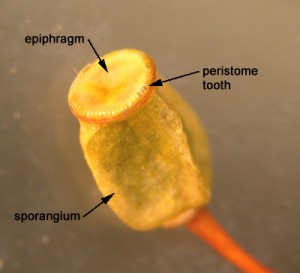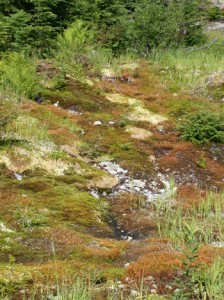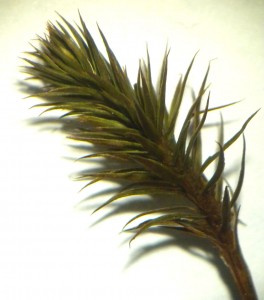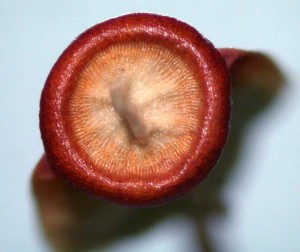Habitat
Polytrichum commune is commonly found in sunny areas, with little to no shade, and can withstand exposure to the sunlight provided that the soil remains moist. Since Polytrichum commune are common on organic soils with persistent moisture, they are frequently found in bogs and swamp sites where they can become quite large in size.
Gametophyte
Overall structure:
Polytrichum commune is an acrocarpous moss and is quite large. It forms in dense, tall, dark green turfs. The leaves are strongly divergent when humid, however they become in-curved or contorted when dry.
Leaf Structure:
Overall, the leaves of
Polytrichum commune are long, slim and pointy. The margins of the leaves are toothed, the teeth being unicellular and embedded in the margin. Another distinguishing feature is the sheathing leaf base.

The lamellae, which are present only on the ventral surface of the leaf, are several cells long with the uppermost cells having a U-shaped notch.The costa is made of stereids, guide cells and hydroids.
Stem:

The stem has distinctive cell layers. Note the cortical region with sclereids, hydrome and leptome. Furthermore, leaf traces are often visible in a stem cross section.
Protonema:
Protonema are uniseriate and filamentous.
Sporophyte
The sporophytic generation generally matures in the summer. Before reaching maturation, the sporangium is erect and once matured becomes angular. The pointy calyptra is whitish to light brown and hairy.
Sporangium:
The square shaped sporangium sits angled when matured and has an operculum that has a small bump at the apex.

Furthermore, the sporangia have an epiphragm, which is a circular membrane that horizontally cover the capsule’s mouth.
Seta:
The seta is red-brown and wiry. In a cross section the cuticle, stereids, and parenchyma cell are apparent; however, the hydroids and leptoids are harder to see.








